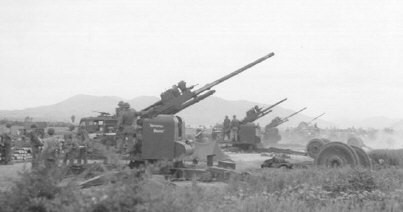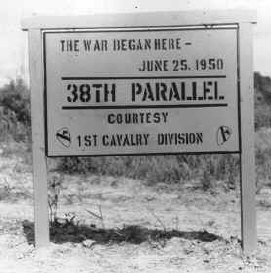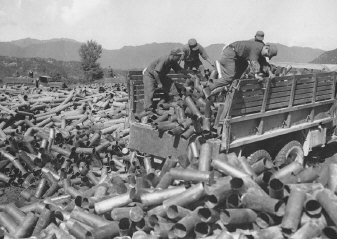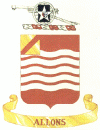Korean War Timeline
Outlined below is a "time line" of the United States
involvement in the Korean War

90mm guns support the
5th Regimental Combat Team,
1st Cav Division, on the Taegu front lines
Photo: US Army
15 Aug 45 - Korea divided into US and Soviet occupation zones along 38th parallel
26 July 47 - President Truman's National Security Act creates US Department of Defense
15 Aug 48 - After supervised elections, US military government turns over power to Republic of Korea
25 Jun 50 - North Korean People's Army invades South Korea - UN calls for an end of aggression

Sign erected by 1st
Cavalry Division at 38th Parallel
showing where the Korean conflict began
Photo: US Army
27 Jun 50 - UN asks member countries to aid Republic of Korea - US announces intervention. North Korea attacks Seoul airfield.
28 Jun 50 - US bombers attack troops in Han River area - North Korean army captures Seoul
30 Jun 50 - President Truman orders ground forces into Korea and authorizes Air Force to bomb North Korea
5 Jul 50 - Near Osan, Task Force Smith troops fight for the first time and suffer heavy casualties
18 Jul 50 - US Cavalry lands at Pohangdong - US aircraft destroy key oil refinery in Wonsan
22 Jul 50 - Battle for Taejon ends with heavy US losses and retreat
4 Aug 50 - Pusan perimeter established in southeastern Korea
13 Aug 50 - First UN counterattack collapses
15 Aug 50 - Four-day battle of "the Bowling Alley" - UN forces hold back North Korean offensive
15 Sep 50 - Inchon landing of UN forces
29 Sep 50 - UN troops complete recapture of Seoul
7 Oct 50 - UN forces cross 38th parallel - UN sanctions defeat of North Korea and attempted reunification
14 Oct 50 - Chinese Communist troops cross Yalu River into Korea
19 Oct 50 - UN captures P'yongyang, the North Korean capital
1 Nov 50 - Chinese attack in force near Unsan
24 Nov 50 - General Douglas MacArthur's final "Home by Christmas" offensive begins
11 Dec 50 - End of Chinese strike against marine and army divisions at Chosin Reservoir - marines retreat
4 Jan 51 - Seoul captured by Chinese
25 Jan 51 - UN forces resume offensive
11 Feb 51 - Chinese counteroffensive begins north of Hoengsong
1 Mar 51 - UN line reaches between the 37th and 38th Parallels
18 Mar 51 - UN forces retake Seoul
11 Apr 51 - MacArthur recalled - General Matthew Ridgway given command
13 Jun 51 - UN forces dig in on the 38th Parallel
10 Jul 51 - Truce talks begin at Kaesong - Communists break off talks six weeks later

6 September 1951
Korean laborers unloading empty shell casings at the
2nd Infantry Division Ordnance Salvage Dump
Photo: US Army
23 Sep 51 - UN forces take Heartbreak Ridge after 18-day battle
27 Nov 51 - Truce talks resume at Panmunjom
28 Mar 53 - North Korean and Chinese leaders agree to POW exchange
18 Apr 53 - Three-day battle of Pork Chop Hill ends in victory for UN forces
26 Apr 53 - Full peace talks resume at Panmunjom
14 Jun 53 - Communist offensive pushes Republic of Korea troops south
18 Jun 53 - South Koreans release 27,000 North Korean POWs, who refuse repatriation
25 Jun 53 - "Little Truce Talks" secure Republic of Korea's acceptance of armistice. Chinese launch massive attacks against South Korean divisions.
10 Jul 53 - Communists return to negotiations
27 Jul 53 - Cease fire signed - fighting ends 12 hours later
4 Sep 53 - Processing of POWs for repatriation begins at Freedom Village, Panmunjom
From the U.S.
Department of Veterans Affairs
June 2000
As we mark the 50th anniversary of
the start of the Korean War,
we present important facts about the veterans of
that war
period, June 27, 1950 to January 31, 1955.
Historical Facts
·
Actual
hostilities occurred from June 27, 1950 to July 27, 1953. However, the war
period was extended to January 31, 1955 by Congress to define a period of
benefit eligibility in the wake of uneasy peace negotiations after July 27,
1953.
·
There were 6.8
million American men and women who served during the Korean War period, June
27,1950 to January 31, 1955.
· There were
54,200 deaths to Americans in service during the period of hostilities, June 27,
1950 to July 27, 1953. Of these, 33,700 were actual battle deaths.
·
There were 7,140
POW’s during the Korean War. Of these, 4,418 returned to the United
States, 2,701 died, and 21 refused repatriation.
·
There have been
131 recipients of the Congressional Medal of Honor among Korean War veterans.
Demographic
Characteristics
In mid-calendar year 2000:
·
There are an
estimated 3.9 million Korean War veterans in the U.S. and Puerto Rico, down
about 21 percent from the nearly 5 million Korean War veterans in 1990.
· Korean War
veterans make up nearly 16 percent of the 24.4 million total veterans.
·
An estimated
848,000 Korean War veterans also served in other war periods: 171,000 in both
WWII and Vietnam, 404,000 only in WWII, and 273,000 only in Vietnam.
· An estimated
86,300 Korean War veterans are women, making up 7 percent of the estimated
number of all female veterans.
· The median age
of Korean War veterans is estimated to be 69 years, with an estimated 336,500
under age 65, 3.25 million aged 65 to 74, and an estimated 363,600 aged 75 or
older.
· The top five
states with respect to the estimated number of Korean War veterans are:
California (430,800); Florida (294,000); Texas (243,300); New York (220,100);
and Pennsylvania (201,400), reflecting the geographic distribution of the
veteran population in general. (See table for state veteran populations.)
According to the
March 1999 Current Population Survey:
·
Eighty percent
of male Korean War veterans were married at the time of the survey, a proportion
similar to non-veteran males of comparable age (65-74).
Between
July 1999 and June 2000:
· There were an
estimated 117,600 deaths among Korean War veterans.
According to the
1990 Census:
·
The racial
composition of the 4.9 million Korean War veterans in the U.S. was: 4.5 million
white (92 percent); 339,400 African American (7 percent); 30,400 American Indian
(less than 1 percent), Eskimo or Aleut; 39,300 Asian or Pacific Islander (less
than 1 percent); and 35,000 of other races (less than 1 percent). There
were an estimated 133,500 Hispanics (3 percent), who may be of any race, among
Korean War veterans.
By 2010:
·
The number of
Korean War veterans is projected to be just under 2.5 million, down 37 percent
from the number estimated for 2000.
· Korean War
veterans are projected to make-up 12 percent of the 20.1 million projected
veterans.
· The number of
female Korean War veterans is projected to be 61,600, making up nearly 5 percent
of the projected number of all female veterans.
The median age of Korean War veterans is projected to be 78.5.
No Korean War veteran is projected to be under the age of 70. Most Korean
War veterans, 56 percent, are projected to be between the ages of 75 and 79.
About one-third, however, are projected to be 80 or older.
Korea
- Participants and Casualties
By: Richard Kolb
with
Tom Campbell and Dick Ecker
Credit: VFW Magazine - June/July 2003
|
Troops serving in theater |
||||
|
Service |
Number |
% of Total |
Hostile Deaths |
% of Total |
|
ARMY |
1,153,000 |
64% |
27,731 | 82% |
|
NAVY |
265,000 |
15% |
506 | 1% |
|
AIR FORCE |
241,000 |
14% |
1,238 | 4% |
|
MARINES |
130,000 |
7% |
4,266 | 13% |
|
Totals |
1,789,000 |
- |
33,741 |
- |
Korean War dates: June 25, 1950 - July 27, 1953
|
US
Army hostile deaths by |
||
|
Infantry |
22,765 |
82% |
|
Artillery |
2,332 |
8% |
|
Engineers |
850 |
3% |
|
Medical |
830 |
3% |
|
Armor |
530 |
2% |
|
Note: These branches account for 98% of all 27,731 Army hostile deaths. |
||
Peak U.S. Troop Strength - July 1953 - 325,270
|
10 deadliest battles |
||
|
Battle |
Combat Fatalities* |
Dates |
|
Pusan Perimeter |
3,603 |
8/4/50 - 9/16/50 |
|
Chosin Reservoir |
1,641 |
11/27/50 - 12/9/50 |
|
Kunu-ri |
1.194 |
11/29/50 - 12/1/50 |
|
Naktong Breakout |
834 |
9/16/50 - 9/27/50 |
|
Hoengsong [story] |
773 |
2/11/51 - 2/13/51 |
|
Taejon |
638 |
7/19/50 - 7/20/50 |
|
Heartbreak Ridge |
616 |
9/13/51 - 10/15/51 |
|
Kum River |
490 |
7/13/50 - 7/16/50 |
|
Unsan |
454 |
11/1/50 - 11/2/50 |
|
Soyang River |
406 |
5/17/51 - 5/20/51 |
|
*This includes killed in action, died of wounds, died while POW and MIAs later declared KIA. |
||
November 26 - December 2, 1950
Deadliest US week (KIA)
3,628
|
Top
10 number of deaths by State |
||
|
|
California |
2,611 |
|
|
Pennsylvania |
2,401 |
|
|
New York |
2,373 |
|
|
Ohio |
1,823 |
|
|
Illinois |
1,789 |
|
|
Texas |
1,779 |
|
|
Michigan |
1,492 |
|
|
Missouri |
944 |
|
|
Indiana |
920 |
|
|
Kentucky |
886 |

KOREA LINKS
Korean War History [1] [2] [3]










